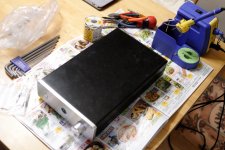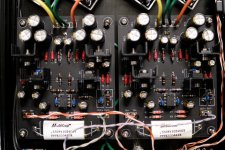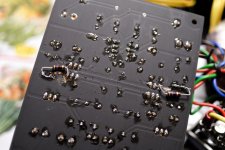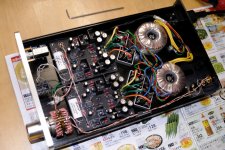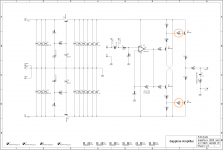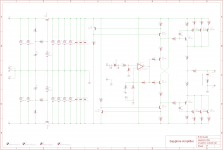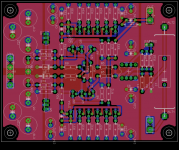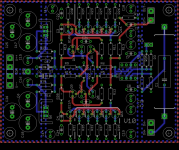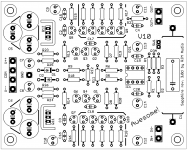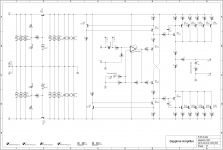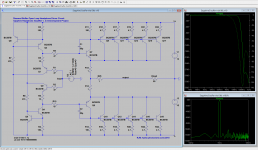If you looking for LTSpice models, you can take a look at LTspiceIV-library Library Listing Expanded - LTwiki-Wiki for LTspice. Optionally you can search for cordell_models.txt
If nothing of above mentioned links works for you I can send you my collection of models.
If nothing of above mentioned links works for you I can send you my collection of models.
Thanks for the kind offer. I'll definitely be borrowing from that wiki in future, particularly for op amps.
The transistors are not critical... the models are close enough for what I need them to do, or to put it another way, there isn't much difference between the different transistors here except at frequencies so high that the simulation is unlikely to be of much use. It's just a small annoyance that the bias set resistors will not match exactly the ones needed in the real circuit.
The transistors are not critical... the models are close enough for what I need them to do, or to put it another way, there isn't much difference between the different transistors here except at frequencies so high that the simulation is unlikely to be of much use. It's just a small annoyance that the bias set resistors will not match exactly the ones needed in the real circuit.
Note: the small bias set resistors (R1,R2 in the LTSpice schematic above, R9,10 on the current Sapphire circuit) really eat into the PSRR, so its not a good idea to make them any larger than absolutely necessary.
If you use a smaller transistor for the driver than the output, the Vbe for equal current is slightly larger so the output bias current is increased without having to resort to the bias set resistors.
From a package point of view, though, its a good idea to have both "mountable" to the heatsink to allow thermal feedback which suppresses thermal runaway in the output.
If you use a smaller transistor for the driver than the output, the Vbe for equal current is slightly larger so the output bias current is increased without having to resort to the bias set resistors.
From a package point of view, though, its a good idea to have both "mountable" to the heatsink to allow thermal feedback which suppresses thermal runaway in the output.
Notes from the mod lab:
Replaced the RC filters (475R + 1nF) before the output transistor bases with a simple damper resistor (47R, carbon comp.).
A bit of background:
I originally borrowed the diamond buffer circuit from the LH0002, around that time I came across a version in an old TI/BB app note (here) which had 50 ohms damping resistors on all four bases. This seemed to me a reasonable precaution, so I included them in the b-board circuit but, imagining they weren't all that important, omitted the second set in the sapphire circuit. (a layout concession...)
This latest mod of mine puts them back in, bringing the b-board and sapphire buffers back to a common point (minus the different bias currents).
I had a hunch that the b-board sounded slightly warmer/smoother than the sapphire, though nothing firm as the two systems were so completely different. Anyhow, adding these resistors to the sapphire seems to add that very slight roundness, a touch of smoothness to the treble. The RC filters did this as well, but it was too much and the sound balanced on the heavy/sluggish side.
This mod (47 ohms on all four bases, as per the Texas Instruments app note OA-07) is officially approved/cleared for the next layout spin.
Replaced the RC filters (475R + 1nF) before the output transistor bases with a simple damper resistor (47R, carbon comp.).
A bit of background:
I originally borrowed the diamond buffer circuit from the LH0002, around that time I came across a version in an old TI/BB app note (here) which had 50 ohms damping resistors on all four bases. This seemed to me a reasonable precaution, so I included them in the b-board circuit but, imagining they weren't all that important, omitted the second set in the sapphire circuit. (a layout concession...)
This latest mod of mine puts them back in, bringing the b-board and sapphire buffers back to a common point (minus the different bias currents).
I had a hunch that the b-board sounded slightly warmer/smoother than the sapphire, though nothing firm as the two systems were so completely different. Anyhow, adding these resistors to the sapphire seems to add that very slight roundness, a touch of smoothness to the treble. The RC filters did this as well, but it was too much and the sound balanced on the heavy/sluggish side.
This mod (47 ohms on all four bases, as per the Texas Instruments app note OA-07) is officially approved/cleared for the next layout spin.
Attachments
Last edited:
A question on resistor selection
Hello, Richard,
Having just recently bought the 2.0 kit, I'm still accumulating the parts to put my Sapphire together. I note these recent mods with interest and, not knowing as much about all this as I'd like, find myself wondering about your experiences with resistor selection. The auditory changes you describe with your latest mod reminds me of my own experiences replacing old carbon composite resistors in vintage Marantz and Sansui gear, in which en masse substitution of modestly-priced Xicon metal film resistors yielded very pleasing results. In the kit you've specified variously Kamaya carbon comps and Vichay metal films, whereas it looks like you've also used Takman and Holco/PRP in your own builds (and, if I'm not mistaken, expressed preference for Vichay or PRP). So, I'm already fighting the urge to substitute metal films for the carbon comps even though I've not yet heard the amp. But what would I be missing?
I wonder if you'd care to comment on the sounds of various resistor type/brand/tolerance in your builds?
Hello, Richard,
Having just recently bought the 2.0 kit, I'm still accumulating the parts to put my Sapphire together. I note these recent mods with interest and, not knowing as much about all this as I'd like, find myself wondering about your experiences with resistor selection. The auditory changes you describe with your latest mod reminds me of my own experiences replacing old carbon composite resistors in vintage Marantz and Sansui gear, in which en masse substitution of modestly-priced Xicon metal film resistors yielded very pleasing results. In the kit you've specified variously Kamaya carbon comps and Vichay metal films, whereas it looks like you've also used Takman and Holco/PRP in your own builds (and, if I'm not mistaken, expressed preference for Vichay or PRP). So, I'm already fighting the urge to substitute metal films for the carbon comps even though I've not yet heard the amp. But what would I be missing?
I wonder if you'd care to comment on the sounds of various resistor type/brand/tolerance in your builds?
@Stan63605 (and arpagon, indirectly)
First my usual disclaimer: it's a %&$# resistor. I would not hold my reputation up to being able to tell the sonic difference between different types, let alone different brands... do whatever you want, pay whatever you feel is necessary.
For my build, I was ordering the Multicap coupling caps from Partsconnexion, so I got the PRP resistors from them at the same time. I've bought Welwyns from them for other projects in the past. I figured why not: they are red, they look cool, and they are not much more expensive than the Vishays at Mouser.
The rest is standard BOM. I use carbon comp. types where, to my way of thinking, resistor inductance is more of a worry than resistor noise, typically the small damping/isolation resistors used after feedback loops, or in front of transistor bases/gates/grids.
So as I said, I wouldn't put money on me being able to tell one from another but since you asked nicely here are my my nominal impressions:
Takman carbon film: I use these in stepped attenuators. I think these are really great: pleasant, warm sound.
Vishay: your standard metal film... invisible but soulless.
Welwyn (The black ones, H4): I haven't used these that often, but every time I have the result has been exceptional. There's this amazing quietness, very smooth and clear.
Xicon. Nasty things, but I consent to use them in the Phonoclone RIAA since Vishay doesn't have those values and I can't be bothered to make up the value as a pair of individual Vishay resistors.
Allen Bradley (and Kamaya and other carbon comp). They are very soft, and just plain noisy which can mask unpleasantness elsewhere (the noise is white in character, so neutral in sound), but noise is just a matter of management: don't use them for the resistors which contribute significantly to the circuit noise, and theres no problem. Very low inductance and negative tempco means they have their usefulness in modern audio.
PRP: Well, they are red. They look cool. They are cheap. What's not to like? Somewhere between Welwyn and Vishay in sound quality.
First my usual disclaimer: it's a %&$# resistor. I would not hold my reputation up to being able to tell the sonic difference between different types, let alone different brands... do whatever you want, pay whatever you feel is necessary.
For my build, I was ordering the Multicap coupling caps from Partsconnexion, so I got the PRP resistors from them at the same time. I've bought Welwyns from them for other projects in the past. I figured why not: they are red, they look cool, and they are not much more expensive than the Vishays at Mouser.
The rest is standard BOM. I use carbon comp. types where, to my way of thinking, resistor inductance is more of a worry than resistor noise, typically the small damping/isolation resistors used after feedback loops, or in front of transistor bases/gates/grids.
So as I said, I wouldn't put money on me being able to tell one from another but since you asked nicely here are my my nominal impressions:
Takman carbon film: I use these in stepped attenuators. I think these are really great: pleasant, warm sound.
Vishay: your standard metal film... invisible but soulless.
Welwyn (The black ones, H4): I haven't used these that often, but every time I have the result has been exceptional. There's this amazing quietness, very smooth and clear.
Xicon. Nasty things, but I consent to use them in the Phonoclone RIAA since Vishay doesn't have those values and I can't be bothered to make up the value as a pair of individual Vishay resistors.
Allen Bradley (and Kamaya and other carbon comp). They are very soft, and just plain noisy which can mask unpleasantness elsewhere (the noise is white in character, so neutral in sound), but noise is just a matter of management: don't use them for the resistors which contribute significantly to the circuit noise, and theres no problem. Very low inductance and negative tempco means they have their usefulness in modern audio.
PRP: Well, they are red. They look cool. They are cheap. What's not to like? Somewhere between Welwyn and Vishay in sound quality.
Last edited:
Well, Richard (my name is Alex BTW) - this was the answer I expected@Stan63605 (and arpagon, indirectly)
Takman carbon film: I use these in stepped attenuators. I think these are really great: pleasant, warm sound.
Vishay: your standard metal film... invisible but soulless.
Allen Bradley (and Kamaya and other carbon comp). They are very soft, and just plain noisy which can mask unpleasantness elsewhere (the noise is white in character, so neutral in sound), but noise is just a matter of management: don't use them for the resistors which contribute significantly to the circuit noise, and theres no problem. Very low inductance and negative tempco means they have their usefulness in modern audio.
My philosophy is that devices must not contribute (or colour) in the sound picture.
And since the Z-foils are expensive for me, I decided to use Vishay Dale CMF55 - they are neutral and their quality is high enough.
Hi Alex,
As you wish. With resistors, people tend to get what they feel comfortable with, what agrees with their philosophy, and that's fine. If you feel comfortable, satisfied with your project ... then you will be predisposed to be pleased with the musical result and that's 'mission accomplished' as far as I am concerned.
But, insofar as carbon composition vs. CMF55 it is an oversimplification to reduce it to just quality:high/low/sufficient. The inductive "neutral" CMF55 could color the sound more than the non-inductive, noisy carbon resistor ... it really depends on the circuit and it is always best to keep an open mind with these things.
As you wish. With resistors, people tend to get what they feel comfortable with, what agrees with their philosophy, and that's fine. If you feel comfortable, satisfied with your project ... then you will be predisposed to be pleased with the musical result and that's 'mission accomplished' as far as I am concerned.
But, insofar as carbon composition vs. CMF55 it is an oversimplification to reduce it to just quality:high/low/sufficient. The inductive "neutral" CMF55 could color the sound more than the non-inductive, noisy carbon resistor ... it really depends on the circuit and it is always best to keep an open mind with these things.
Wasn't aware of the inductance issue
I guess it's one thing to replace schmutzy 35-year-old carbon comp resistors with new metal films - even 'nasty' Xicons (I have often wondered if I'd hear the difference of 'better' MF's, say, Vichay). But with today's carbon-comp resistors, maybe not such a clear choice. I'll build the boards as per the kit contents. Thanks for the insight.
I guess it's one thing to replace schmutzy 35-year-old carbon comp resistors with new metal films - even 'nasty' Xicons (I have often wondered if I'd hear the difference of 'better' MF's, say, Vichay). But with today's carbon-comp resistors, maybe not such a clear choice. I'll build the boards as per the kit contents. Thanks for the insight.
Updated links for the aluminum chassis I used to case up this amp.
Headphone Amplifier Aluminium Chassis 01 [Case 01] - $75.00 : DAC,Audio Amplifier,Hifi Amplifier,Tube Amplifier,Hlly Audio, Hlly Electronics
Headphone Amplifier Aluminium Chassis 02 [Case 02] - $75.00 : DAC,Audio Amplifier,Hifi Amplifier,Tube Amplifier,Hlly Audio, Hlly Electronics
These links do not take me to the same website (I think), any idea what's happened to hlly audio?
They were an off-again on-again outfit with pretty flaky reliability. Looks like hlly audio has finally gone dark.
The parent site hllyelectronics is still live.
I suggest going to ebay, there's tons of different options, cheap and ebay protects you as a buyer. Or try aliexpress if you are brave. It's pretty wild out there.
The parent site hllyelectronics is still live.
I suggest going to ebay, there's tons of different options, cheap and ebay protects you as a buyer. Or try aliexpress if you are brave. It's pretty wild out there.
They were an off-again on-again outfit with pretty flaky reliability. Looks like hlly audio has finally gone dark.
The parent site hllyelectronics is still live.
It looks live, but the 'Contact Us' link is '404 page not found'. I paypal'd them a couple weeks ago for case 02, it's been pretty quiet.
Not just the contact info, most of the pages return 404s. That's nothing new though, their webpage has always been like that.
The address and phone number are at the bottom of the main page, and its dated 2015.
I think the best thing is to take it up with Paypal. If your case shows up in a couple of weeks, and it may well, great, but if I were you I'd plan for the event that it does not.
The address and phone number are at the bottom of the main page, and its dated 2015.
I think the best thing is to take it up with Paypal. If your case shows up in a couple of weeks, and it may well, great, but if I were you I'd plan for the event that it does not.
A sneak peak at Sapphire 3.0.
(still "alpha")
Hi Richard!
I've been thinking about building a Saphire kit for some time, but it hasn't been a priority. Is a 3.0 kit likely to be available in the forseeable future?
Foreseeable? ... Yes. I plan to proceed with this.
1. Look at the circuit closely for "gotchas" like thermal stability. Final selection of packages.
2. Board layout.
3. Fabrication. Build, test, and optimize values on the prototype.
.
. assuming no catastrophic problems, no re-spin needed, and that it is better than the current 2.0, then
.
4. Supersedes rev 2. as the shipping version.
All going well, you are still looking 6 months to get to 4. The new boards will be drop-in replacements, though, so an upgrade 2.0->3.0 will be relatively easy.
1. Look at the circuit closely for "gotchas" like thermal stability. Final selection of packages.
2. Board layout.
3. Fabrication. Build, test, and optimize values on the prototype.
.
. assuming no catastrophic problems, no re-spin needed, and that it is better than the current 2.0, then
.
4. Supersedes rev 2. as the shipping version.
All going well, you are still looking 6 months to get to 4. The new boards will be drop-in replacements, though, so an upgrade 2.0->3.0 will be relatively easy.
Sapphire Headphone Amplifier rev. 3.0d "V10"
Flat of pnp faces right, npn faces left. The layout is overall quite logical and neat ... it worked out a lot better than I had imagined it would.
As promised, a simple (and completely optional) gain switch (hi/lo) has been implemented, SW1. The 5+5 output transistor banks can be partially populated, as desired.
Generally speaking the output gain is fine-tuned by trimming R9,R10. The correct value to give about 5-7 mA in each output transistor will be ascertained during the testing phase.
Flat of pnp faces right, npn faces left. The layout is overall quite logical and neat ... it worked out a lot better than I had imagined it would.
As promised, a simple (and completely optional) gain switch (hi/lo) has been implemented, SW1. The 5+5 output transistor banks can be partially populated, as desired.
Generally speaking the output gain is fine-tuned by trimming R9,R10. The correct value to give about 5-7 mA in each output transistor will be ascertained during the testing phase.
Attachments
- Home
- Amplifiers
- Headphone Systems
- RJM Audio Sapphire Desktop Headphone Amplifier
